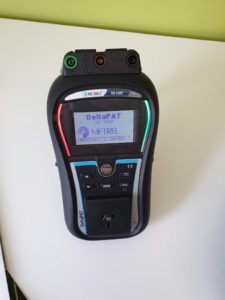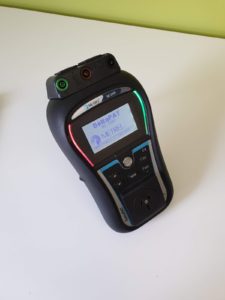
The Metrel DeltaPAT has been on the market for many years, it enables compliance with ASNZS3760 is very quick and easy to use in most testing situations, it was when introduced to the Australian NZ market by Metrel, there first compliance only PAT, previous models such as the AlphaPAT had multiple protective earth testing options, which meant people could choose ‘safety testing’ rather than just ‘compliance testing’.
Originally not being Bluetooth capable the unit would frustrate users when trying to enter data by ‘scrolling’, however with the App and Bluetooth functionality the data entry issue all but disappears
Here’s a Quick Review of the Metrel DeltaPAT 3309 BT

PROS
A big positive feature of this unit is the ability for the user to select Auto Test Codes, this ensures if the correct code is entered and correct testing performed that the result is always correct be it a pass or fail.
For those more keen on getting the job done quickly and not so concerned with the best practice testing this little PAT seems a good choice and this’ll be why it has proven very popular, it is quick and easy to use and providing it’s not used as a total “test and tag print solution” and is light and small.
It is often sold in a big bulky and heavy pelican style case making a very small light PAT the opposite
CONS
The unit has always been unable to successfully test RCDs when used in some of the auto test codes
Bluetooth operation is only available on Android devices, so for some user’s data entry will be a nightmare or alternatively they may choose not to keep records which is not a step forward for safety!
Other negatives are the ability to muddle up the test leads ie putting them in the wrong socket.
The biggest shortcoming of this PAT is it’s in ability to test the integrity of the earth, what I mean by that is it cannot simulate a REAL likely fault current through the protective earth!
Please remember the protective earth is what may save someone’s life.
The earlier model Metrel AlphaPAT could test the protective earth by applying up to 25000 milliamps through it whereas the Delta can only apply 200 milliamps, quite a difference we think!
As with any other old yet updated equipment there are numerous other issues, but most are of a more minor nature.
BOTTOM LINE
The DeltaPAT when compared to most other PAT ‘s stacks up pretty well on price and features.
In its defence other small handheld PAT ‘s can only do similar ‘compliance only testing’ except the new EasiPAT 10 which as its name suggested can test the protective earth at either 200 or 10000 milliamps.
Both are similarly priced and of a similar size and weight, but some other features of the EasiPAT 10 suggest the designers were more focused on safety than the Delta designers.
Summing up it is an easy to use (mostly) PAT at a reasonable value for money price capable of complying with ASNZS3760, but definitely not the leader amongst its peers.
FEATURES
All the necessary features and many useful and desirable ones are available on board or as an optional accessory however unfortunately what could have made this a very good tester is missing, that being the ability to test not only for compliance but also for safety!
Data entry works well, if done through the App, the Tag printing systems available for this PAT haven’t really changed since their introduction many years ago except for the introduction of the QR code so the tagging system is fairly primitive.
Failed / Danger tags aren’t always particularly distinguishable from a pass tag which isn’t ideal.
The Green for pass or Red for fail LED system on the Delta works very well ensuring the actual testing person cannot really mistake the outcome of the test result.

TESTING CAPABILITIES
The Delta can be used in 3 modes Auto test shortcut, Simple test or Single test, organisation’s wanting to ensure there testing remains consistent amongst all users are best to use the Auto test codes as these are not user changeable whereas the Simple test and Single test are.
Substitute leakage is available on this PAT, but the AU/NZ users need to be aware this isn’t recognized under our Standard and therefore shouldn’t be used.
RCD testing works fine provided you don’t try and use test code 184 as the polarity testing will cause the test to fail
As with all low current (200 milliamp compliance only PAT ‘s) sometimes the testing person may have trouble getting an accurate earth resistance reading which is often indicated by a false earth test failure, this is very annoying and novice testing persons will often end up with many of these.
The Delta also does suffer from this problem, those familiar with the problem will also be familiar with how to avoid the situation but still it just adds another hassle in to your day.
CONCLUSION
The DeltaPAT looks nice and appears easy to use and enables the user to comply with ASNZS3760 therefore it is an easy seller, however we think it sells well because it’s an easy sell and not because it’s a great PAT, in fact when it comes to testing if you’re interested in safety not just compliance the answer to the question, should I buy one is simple ? No

 Product eligibility and replacement
Product eligibility and replacement
 Electric shocks can be fatal so whether it is at the bank, hotel, school, factory or farm we want to help make a difference. Many farms and older business may have a lot of gear, be it guns, tractors or tools, so how do you know what is electrically safe? When it comes to electrical safety, age can increase the likelihood of something becoming unsafe, however even newish equipment may actually hide deadly unseen secret defects.
Electric shocks can be fatal so whether it is at the bank, hotel, school, factory or farm we want to help make a difference. Many farms and older business may have a lot of gear, be it guns, tractors or tools, so how do you know what is electrically safe? When it comes to electrical safety, age can increase the likelihood of something becoming unsafe, however even newish equipment may actually hide deadly unseen secret defects. The Farm Electrical Safety Package Giveaway will include:
The Farm Electrical Safety Package Giveaway will include:





 Multimeters
Multimeters Portable appliance testers (PATs) are handheld or compact devices that test a range of electrical equipment and appliances for different values, i.e. earth continuity, current leakage, insulation, etc.
Portable appliance testers (PATs) are handheld or compact devices that test a range of electrical equipment and appliances for different values, i.e. earth continuity, current leakage, insulation, etc.



